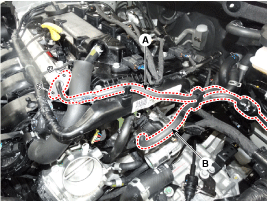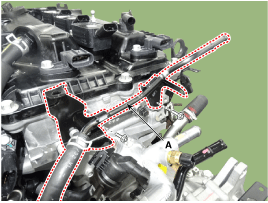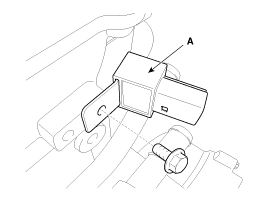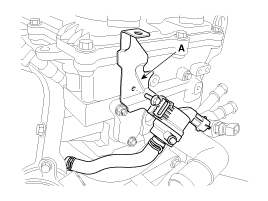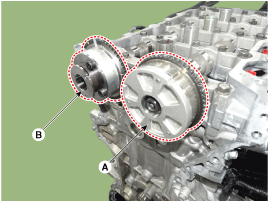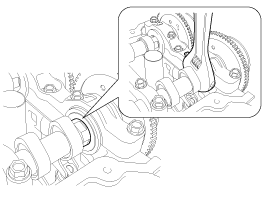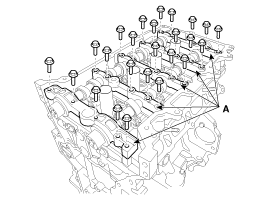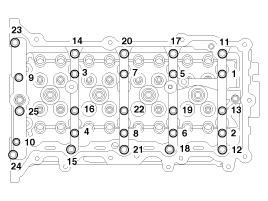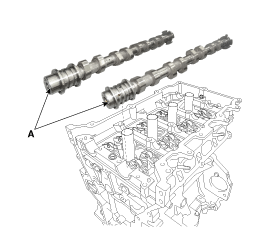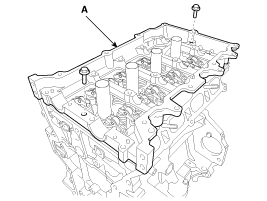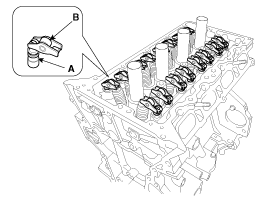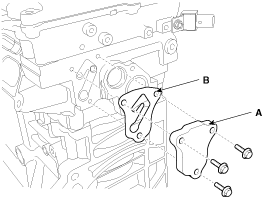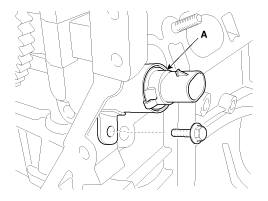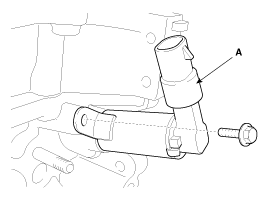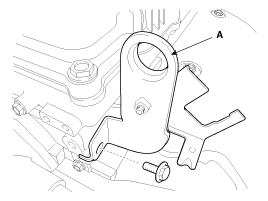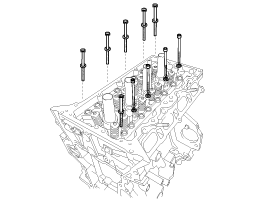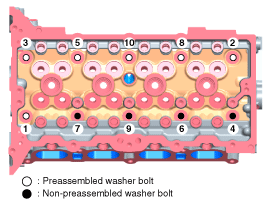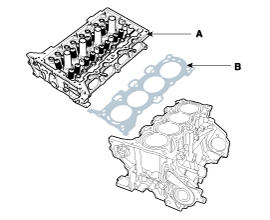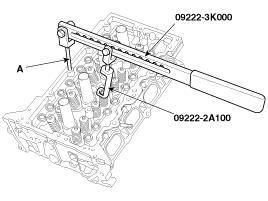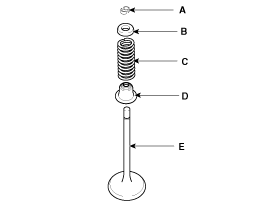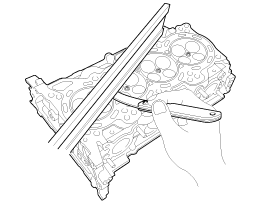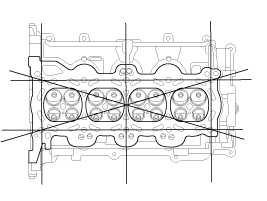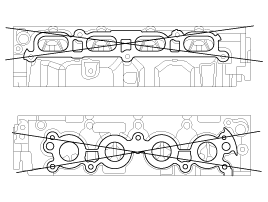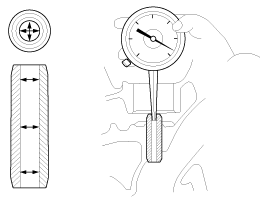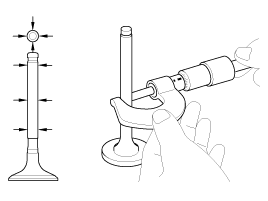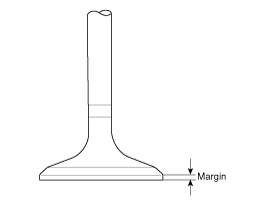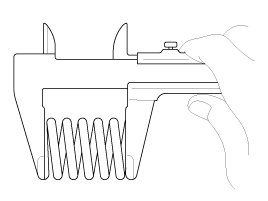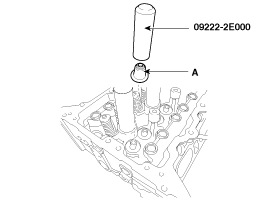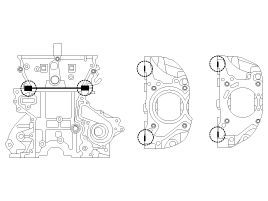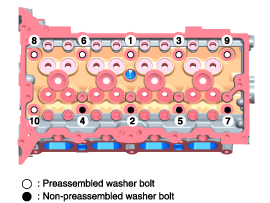Hyundai Elantra: Cylinder Head Assembly / Cylinder Head Repair procedures
Hyundai Elantra AD (2016-2020) Service Manual / Engine Mechanical System / Cylinder Head Assembly / Cylinder Head Repair procedures
| Removal |
Engine removal is not required for this procedure.
|
|
| 1. |
Remove the engine cover.
(Refer to Engine And Transaxle Assembly - "Engine Cover") |
| 2. |
Remove the air duct and air cleaner assembly.
(Refer to Intake And Exhasut System - "Air Cleaner") |
| 3. |
Remove the battery.
(Refer to Engine Electrical System - "Battery") |
| 4. |
Remove the ECM (Engine Control Module).
(Refer to Engine Control / Fuel System - "Engine Control Module (ECM)") |
| 5. |
Remove the battery tray.
(Refer to Engine Electrical System - "Battery") |
| 6. |
Remove the engine room under cover.
(Refer to Engine And Transaxle Assembly - "Engine Room Under Cover") |
| 7. |
Drain the coolant.
(Refer to Cooling System - “Coolant”) |
| 8. |
Disconnect the fuel hose (A) and purge control solenoid valve (PCSV) hose (B).
|
| 9. |
Remove the vacuum pipe (A).
|
| 10. |
Remove the condenser (A).
|
| 11. |
Remove the purge control solenoid valve (PCSV) bracket (A).
|
| 12. |
Remove the delivery pipe.
(Refer to Engine Control/Fuel System - “Delivery Pipe”) |
| 13. |
Remove the cylinder head cover.
(Refer to Cylinder Head Assembly - “Cylinder Head Cover”) |
| 14. |
Remove the timing chain.
(Refer to Timing System - “Timing Chain”) |
| 15. |
Remove the exhaust manifold.
(Refer to Intake And Exhaust System - “Exhaust Manifold”) |
| 16. |
Remove the intake manifold.
(Refer to Intake And Exhaust System - “Intake Manifold”) |
| 17. |
Remove the water temperature control assembly.
(Refer to Cooling System - “Water Temperature Control Assembly”) |
| 18. |
Remove the heater pipe.
(Refer to Cooling System - "Thermostat") |
| 19. |
Remove the intake CVVT assembly (A) and exhaust CVVT assembly (B).
|
| 20. |
Remove the camshaft.
|
| 21. |
Remove the cam carrier (A).
|
| 22. |
Remove the hydraulic lash adjuster (HLA) (A) and the swing arm (B).
|
| 23. |
Remove the oil control adapter (A) with the gasket (B).
|
| 24. |
Remove the intake oil control valve (OCV) (A).
|
| 25. |
Remove the exhaust oil control valve (OCV) (A).
|
| 26. |
Remove the rear engine hanger (A).
|
| 27. |
Remove the spark plugs.
(Refer to Engine Electrical System - “Spark Plug”) |
| 28. |
Remove the cylinder head.
|
| Disassembly |
|
| 1. |
Remove the valves.
|
| Inspection |
Cylinder Head
| 1. |
Inspect for flatness.
Using a precision straight edge and feeler gauge, measure the
contacting surface of the cylinder block and the manifolds for warpage.
|
| 2. |
Inspect for cracks.
Check the combustion chamber, intake ports, exhaust ports and
cylinder block surface for cracks. If cracked, replace the cylinder
head. |
Valve And Valve Spring
| 1. |
Inspect valve stems and valve guides.
|
| 2. |
Inspect the valves.
|
| 3. |
Inspect the valve seats and the valve guides.
|
| 4. |
Inspect the valve springs.
|
Hydraulic Lash Adjuster (HLA)
With the HLA filled with engine oil, hold A and press B by hand.
If B moves, replace the HLA.
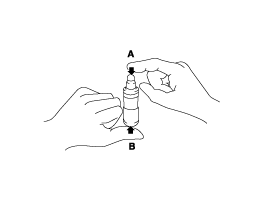
| Problem | Possible cause | Action | |||
| 1. Temporary noise when starting a cold engine | Normal | This noise will disappear after the oil in the engine reaches the normal pressure. | |||
| 2. Continuous noise when the engine is started after parking more than 48 hours | Oil leakage of the high pressure chamber on the HLA, allowing air to get in | Noise will disappear within 15 minutes when engine runs at 2000-3000 rpm. If it doesn’t disappear, refer to step 7 below. | |||
| 3. Continuous noise when the engine is first started after rebuilding cylinder head | Insufficient oil in cylinder head oil gallery | ||||
| 4. Continuous noise when the engine is started after excessively cranking the engine by the starter motor or band |
| ||||
| 5. Continuous noise when the engine is running after changing the HLA |
| ||||
| 6. Continuous noise during idle after high engine speed | Engine oil level too high or too low |
| |||
| Excessive amount of air in the oil at high engine speed | Check oil supply system. | ||||
| Deteriorated oil | Check oil quality. If deteriorated, replace with specified type. | ||||
| 7. Noise continues for more than 15 minutes | Low oil pressure | Check oil pressure and oil supply system of each part of engine. | |||
| Faulty HLA | Remove the cylinder head cover and press HLA down by hand. If it moves, replace the HLA. | ||||
| Reassembly |
|
| 1. |
Install the valves.
|
| Installation |
|
| 1. |
Install the cylinder head gasket (B) on the cylinder block.
|
| 2. |
Place the cylinder head (A) carefully to protect damage to the head gasket during installation.
|
| 3. |
Install the cylinder head bolts with washers.
Using SST (09221-4A000), install and tighten the 10 cylinder head bolts, in several passes, in the sequence as shown.
|
| 4. |
Install the rear engine hanger (A).
|
| 5. |
Install the exhaust oil control valve (OCV) (A).
Components
1. Camshaft bearing cap2. Camshaft front bearing cap3. Exhaust camshaft4. Intake camshaft5. Exhaust CVVT assembly6. Intake CVVT assembly7. Cam carrier8. Cylinder head9. Cylinder head g ...
|



